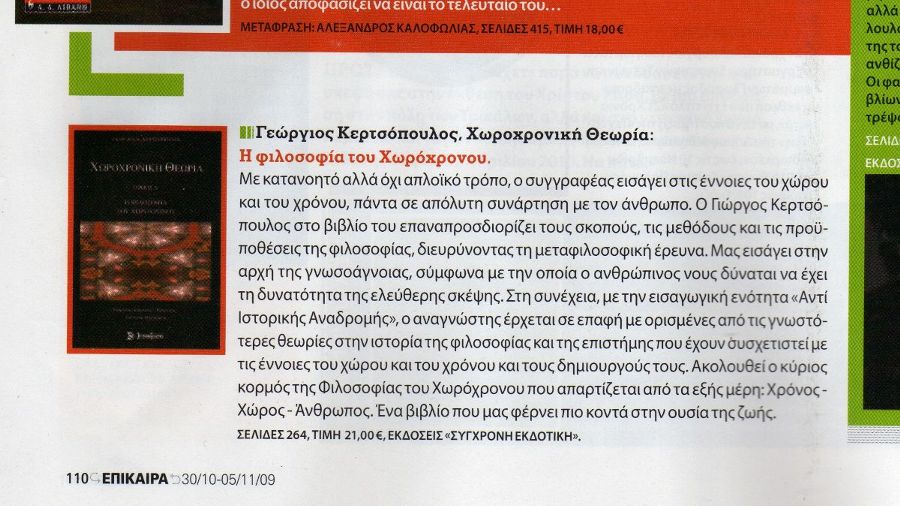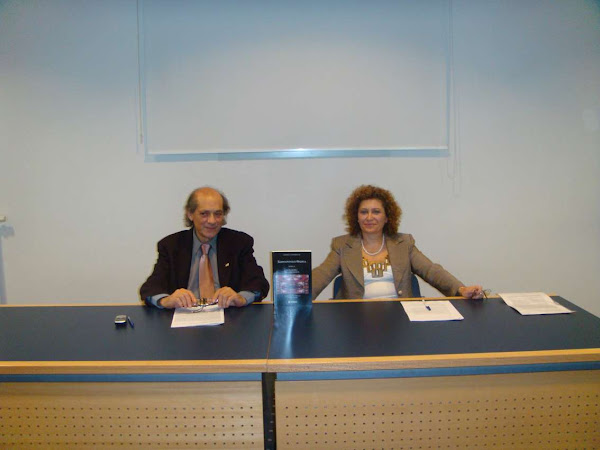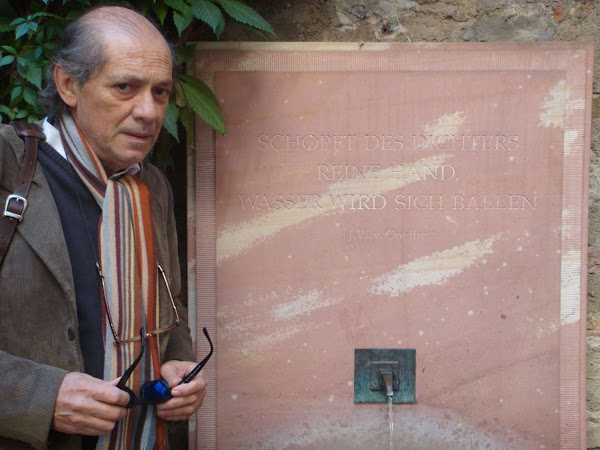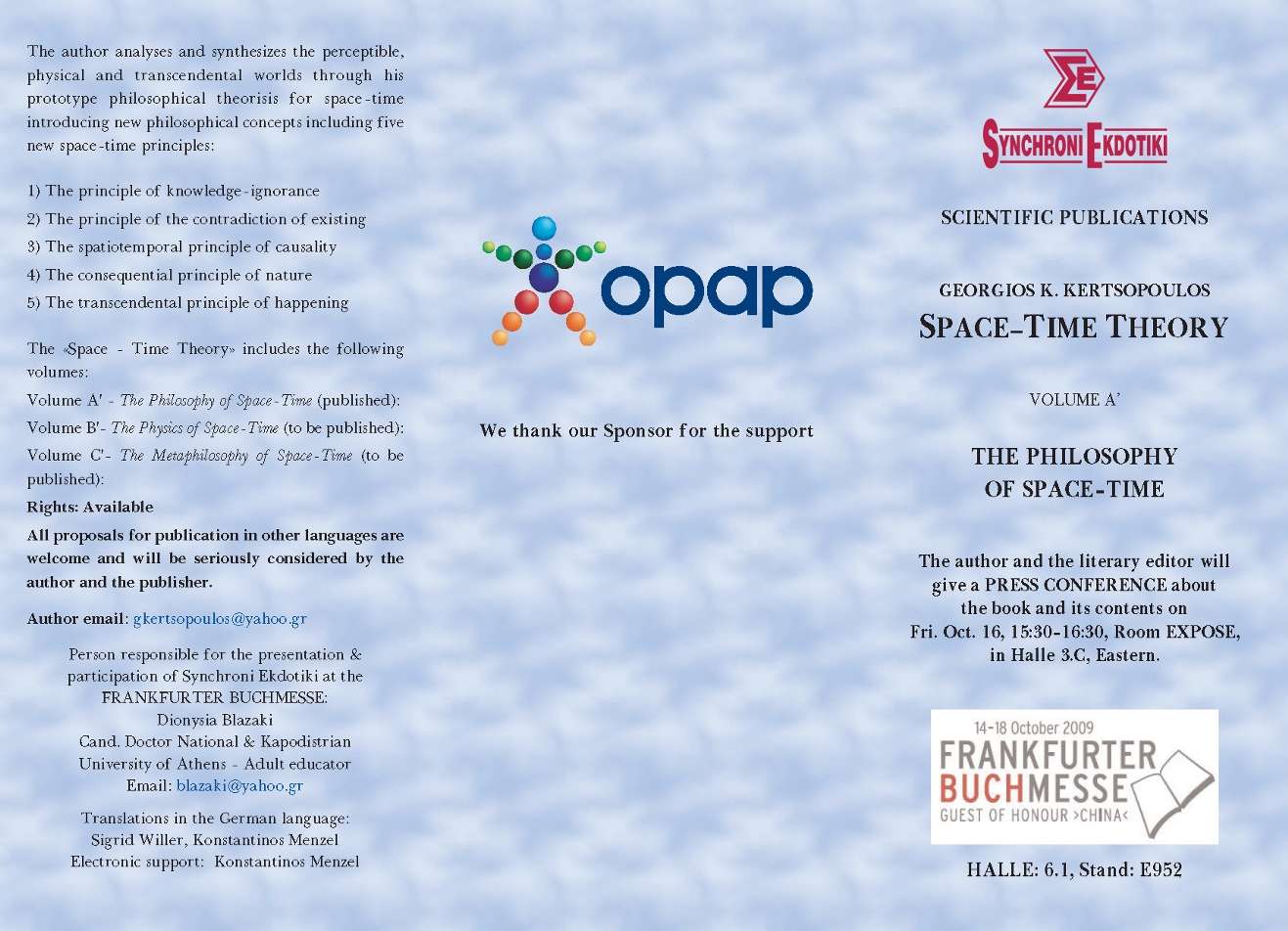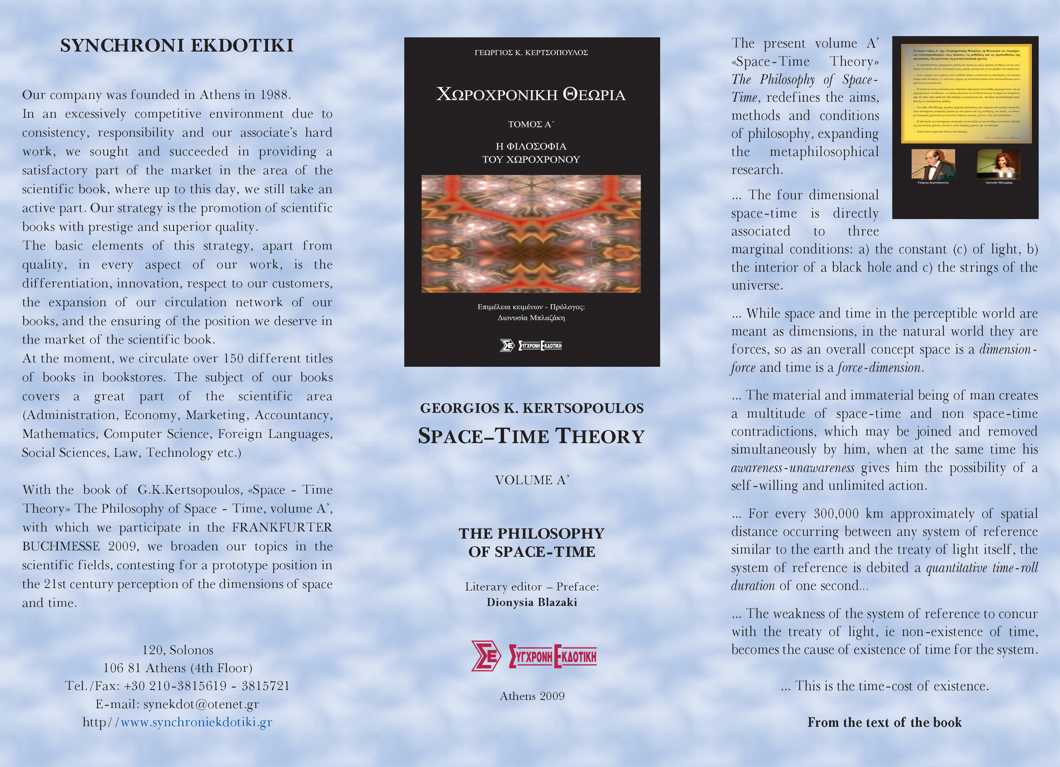Georgios K. Kertsopoulos
Space-Time Theory
VOLUME A’
The Philosophy of Space-Time
Abstract of the book
The present volume A΄ of the Space-Time Theory: the Philosophy of Space-Time, redefines the aims, methods and presuppositions of philosophy, expanding the metaphilosophical research.
From the beginning of the preface already, the author introduces the principle of knowledge-ignorance according to which the human mind is able to possess the possibility of freethinking. Following that, with the introductory unity “Instead of a Historic Retrospection”, which is imprinted with a fictitious, dramatized manner, the reader comes in contact with some of the most known and eminent theories in the history of philosophy and science which have been correlated with the concepts of space and time. This unity has an extent of twenty-four pages and resembles a manual in the form of a scientist’s-philosopher’s dialogue, necessary however for the study and the comprehension of the specific treatise.
The main body of the Philosophy of Space-Time consists of the following three parts: Time-Space-Man. There follows an appendix, glossary and bibliography. Each part starts with an introductory text and there follow the chapters that are apportioned in unities some of which also include sub-unities. Those texts that present new functions or interrelations are accompanied by schematic representations and cartographic drawings to facilitate the comprehension of the newly defined concepts.
In the first and second part, the concepts of “time” and “space” are examined respectively in a historic, causal and etymological manner. According to the theory of the under-bases (υποβάθρων), which is unfolded in the second chapter of the first part for time and in the third chapter of the second part for space, it is indicated that the time of nature rolls in between two marginal conditions of null time-roll. These two known conditions where there is no existence of time-roll are: a) the conditional treaty of the speed of light itself and b) the conditional treaty of infinite density existing in the interior of a black hole. Also, it is defined as quantity of time-roll duration the phenomenon of the total increase and decrease that occurs in the duration of the time roll in every different system of reference. As a consequence of the above, nature and life, as systems of reference that possess the specific, earthly finite gravitational potential are debited one second of time-roll for every 300,000 Km approx. that they keep spatially from the treaty of light. This is the time-cost of existence.
Moreover, it is determined that, while space and time in the perceptible world are meant as dimensions, in the natural world are forces and for this reason, space as an overall concept, is a dimension-force and time is a force-dimension. Conclusively, and as we read in the last chapter of the second part, the four-dimensional space-time of the perceptible world with its three spatial dimensions of width, height and length and the one dimension of time, is directly associated with the three marginal conditions: a) the constant (c) of the speed of light, b) the interior of a black hole and c) the strings of the universe. In addition, in the second part of “space” the principle of the contradiction of existing (υπάρχειν) is introduced, according to which, the apparent-seeming (φαίνεσθαι) that concerns the world of phenomena and is approached with the senses and the perception is in contradiction with the existing (υπάρχειν), which as an object of reason (νοούμενον) is approached by the intellect. Also, in the second chapter of “space” the spatiotemporal principle of causality is determined, which expands the predominant relation of cause-effect, by interposing the happening between them and renaming the effect to the defined term: consequence of the happening (effect). The spatiotemporal principle of causality is designated with the geometric form of the ternary-triangular scheme: cause-happening-consequence of happening (effect) and as a perceptible principle governs the perceptible world. Another principle, which however governs the natural world, is the consequential principle of nature, describing the way nature as a subject co-functions with man as an object, always in reference to the spatiotemporal principle of causality. The spatiotemporal principle of causality, the consequential principle of nature and the transcendental principle of happening synthesize the three out of five fundamental principles introduced by the Philosophy of Space-Time. Their coordinated function is explained extensively in the appendix and is represented graphically in the first page of the book.
The third part of the book, that bears the title “Man” is constituted by five chapters and exceeds in extent the total length of the other two parts. In its introduction we read the poetic phrase “Intrusion to the furthest places of the universe, Man”. The whole part is inundated by space-time determinations and definitions of newly introduced terms but also from regaining new concepts from the already defined known terms.
The first chapter examines “the limits between the perceptible world and man” and with this relation as a reference treats and deals with the concepts and the terms of the sensation, the conscience and the cosmic becoming (γίγνεσθαι). This examination has as a foundation the research results of Prof. Konstantinidis “a new concept of the function of the sensory and special sense neuron”, which states that for the conscious perception of the sensations there must be a pre-occurrence of the outward projection, because the localization of the sensation and the perception of the totality of the sensations takes place outside of the body, at the surrounding space.
The second chapter, “The operation of perception” presents extensively and maps cartographically all the centers that are related with the operation of perception and contribute to the communication of man with the world of sensual things, the world of cosmic becoming (γίγνεσθαι).
In the third chapter we are given “the spatiotemporal and non-spatiotemporal relation of man with the perceptible and the transcendental world”. In the first unity is defined the spatiotemporal relation of the being (είναι) with the ego (εγώ) and the non-ego (μη εγώ) and also the being with the non-being (μη είναι), while in the second unity are determined the three philosophical spatiotemporal arrows of the perceptible world, which are as follows: the first spatiotemporal arrow is directed from the past determination (προσδιοριστία) to the future indeterminacy (απροσδιοριστία) and is responsible for the entropy of the universe but also for the contradictions embedded in the phenomena of the perceptible world. The second space-time arrow is directed from the past form to the future content and contributes to the continuous transformation of the masso-enenergetic (υλοενεργειακών) forms and consequently to the principle of the preservation of energy. The third space-time arrow is directed from the past being to the future non-being and it is the one that is responsible for the following two inviolable functions: a) for prohibiting the passing into the future without the intervention of the present and b) for prohibiting the passing into the opposite direction (towards the past). In their unity, the three spatiotemporal time arrows of the perceptible world, create for the past the determined form of being and for the future the indeterminable content of the non-being.
The third unity of this chapter develops “the operation of thought” and the processes under which the thought becomes the energetic essence-non essence and when correlated with the operations of a) the ego, acquires perceptible character and becomes perceptible thought, b) the non-ego, obtains transcendental character and becomes transcendental thought, while c) when united with the being, becomes pure thought.
The fourth chapter examines the “spatiotemporal functions and spatiotemporal phase differences”. The term spatiotemporal phase differences correlates with the different space-times, with which, man operates as a whole and according to the principle of the contradiction of existing, they are so accurately spatiotemporally-synchronized by nature, that it becomes impossible for the perception to perceive the existing spatiotemporal phase differences. The first unity localizes and imprints schematically the least spatiotemporal functions that are necessary for the perception by man, of one and only phenomenon, in their simple but also detailed operation, while the three following unities refer to the world of Ideas, the unconscious and to the conclusions that evolve, which are defined by nine spatiotemporal attributes.
The fifth and last chapter presents and maps cartographically the thirteen spatiotemporal and non-spatiotemporal centers that exist between the ego and the soul of man and the three dimensions that exist outwards of him along with chaos and eternity. A very dense in concepts chapter, which in the six unities it contains presents the relations and the functions that develop in the centers of the inner human or the relations these centers have with the outward worlds and dimensions. The quantities that are created by the under-base potential differences are given along with elements involved in the migration of the sensations and also spatiotemporal correlations involved in form and content. All these determinations and combinations conclude with the sixth and last unity explaining that man is the bearer that stands in-between space-time and non space-time because as we read at the end …the material and immaterial substance of man creates a multitude of spatiotemporal and non spatiotemporal contradictions, which may be joined and removed simultaneously by him, when at the same time his knowledge-ignorance gives him the possibility of a self-willing and unlimited action.
The literary editor of the book
Dionysia Blazaki




